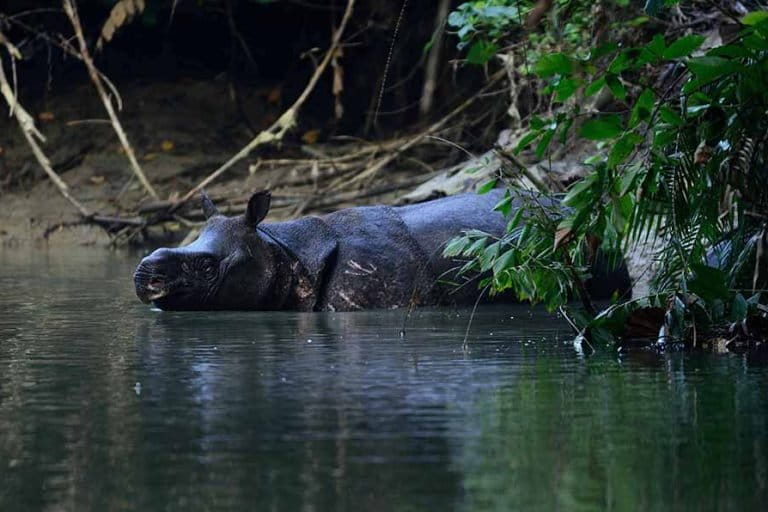- Working in Javan rhino protection programs is no mean feat, according to locals who have dedicated decades of their lives to the endeavor.
- From getting chased by rhinos to meeting face-to-face with armed hunters, their experiences speak to the often grueling reality of on-the-ground conservation work, highlighted by rare encounters with the elusive animals.
- Yet despite the challenges, the workers say they have found worth in their daily duties, and have come to value the rhinos even more as a result.
BANDUNG, Indonesia — Sarmidi joined a conservation program for the Javan rhino in 1980. But it wasn’t until 2008 that he finally met one of the elusive creatures. And it wasn’t his finest moment, he admits.
He’d been working for the Rhino Observation and Activity Management (ROAM) program for nearly three decades when he quite literally stumbled across a rhino wallowing in a mud pit in Ujung Kulon National Park on the western tip of Java.
“I was so startled when I almost stepped on the rhino’s head while it was wallowing,” Sarmidi, 67, told Mongabay. “I ran away as fast as I could and climbed up the nearest tree.”
He later learned that the rhino was a 25-year-old male whom the park management called Rawing.

ROAM is a partnership between WWF-Indonesia and Ujung Kulon National Park, the only place on Earth that’s home to the critically endangered Javan rhinoceros (Rhinoceros sondaicus), also known as the lesser one-horned rhino.
Set aside as a protected area since Dutch colonial rule in the 1920s, Ujung Kulon has long been a safe haven and stronghold for Javan rhinos. But this final habitat faces a number of threats, including incursions by humans.
Dozens of people have been caught carrying out illegal activities in the heart of the park, according to a 2017 report from the park agency. These include hunting birds and lesser mouse-deer (Tragulus kanchil); gathering honey, wood and palm resin for making dye; and even planting rice and other crops.
Poaching and habitat loss have put the Javan and Sumatran rhinos on the IUCN’s list of critically endangered species, or a step away from vanishing from the wild.
That’s where locals like Sarmidi come in. One of his main tasks with the rhino protection program is to track bootprints and spot garbage and other signs of human activities in the park.
“We even came face-to-face with hunters once,” he said, referring to an incident from 2004. “They had a rifle while we only had a machete. Luckily we managed to handle the situation.”
Doyok, 40, has been involved with the ROAM program for five years now, but has already logged a memorable first meeting with a rhino, a male named Robot because of the way it drags its left hind leg when it walks. Robot is also known to be more aggressive than other Javan rhinos, the most timid of all rhino species. Doyok said he was chased by Robot when they met.
“I’ve become nervous and vigilant ever since,” he said. “I worry it might happen again, but that hasn’t discouraged me from helping set up camera traps.”
The park’s research station has been working on surveying the rhino population using camera traps since 2011. During nine months of monitoring that first year, they obtained 427 video clips of Javan rhinos in their natural habitat.
A more expansive survey carried out in 2013, which obtained 1,660 video clips of rhinos, allowed researchers to calculate a minimum population of 58 individuals: 35 males and 23 females.

Sarmidi and Doyok are two of dozens of locals who have taken part in the rhino protection program at Ujung Kulon. Many of them have stories about long days of trekking through dense forest and nights of camping outdoors, crowned with rare and memorable encounters with the animals at the heart of it all.
Some 50 locals are now involved in the conservation program, split up into seven units, says Iwan Podol, the species coordinator from WWF-Indonesia who is working with the Ujung Kulon park management.
“The involvement of local people is expected to reduce threats and at the same time beef up security,” Iwan said, adding that there were now camera traps installed in 120 spots that needed to be monitored regularly.
Protecting the habitat is highly crucial to conserving the species, he said. Data from April puts Ujung Kulon’s rhino population at a minimum of 68 individuals: 29 adult males, 24 adult females and 15 juveniles. That figure is an update that followed the birth of two calves earlier this year and the natural death of an adult male in April.
But even as the population holds steady, Javan rhinos still face a number of dangers. With just the one habitat, the species is particularly vulnerable to threats from human activity, disease and natural disasters. The park is in the shadow of an active volcano, and recent research suggests a large tsunami could wipe out virtually the entire species.

These threats have driven wildlife experts and government officials to try to find a second site where part of the rhino population can be relocated, to establish a new population of the species. The current shortlist includes locations in western Java, but some experts have suggested sites in Sumatra, which is already home to a distant cousin, the Sumatran rhino (Dicerorhinus sumatrensis), also critically endangered.
Despite the hardship of the job, Doyok says he prefers being involved in the rhino protection program to his previous occupation as a honey gatherer and bird hunter.
“If you think about it, the Javan rhinos have helped us provide food and livelihoods for our families,” he said. “Our lives become more meaningful.”

This story was reported by Mongabay’s Indonesia team and was first published on our Indonesian site on July 27, 2018.
FEEDBACK: Use this form to send a message to the author of this post. If you want to post a public comment, you can do that at the bottom of the page.